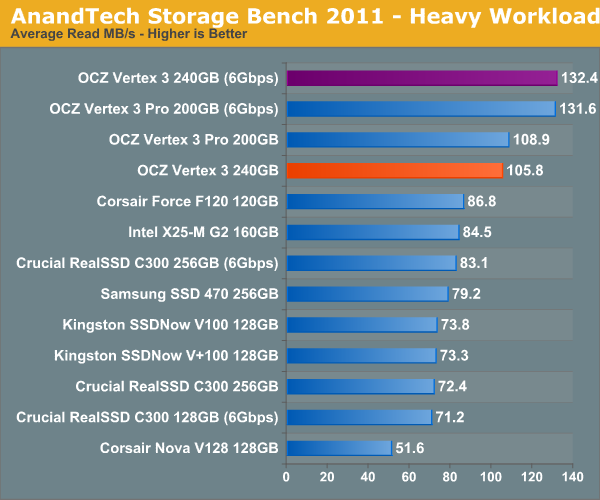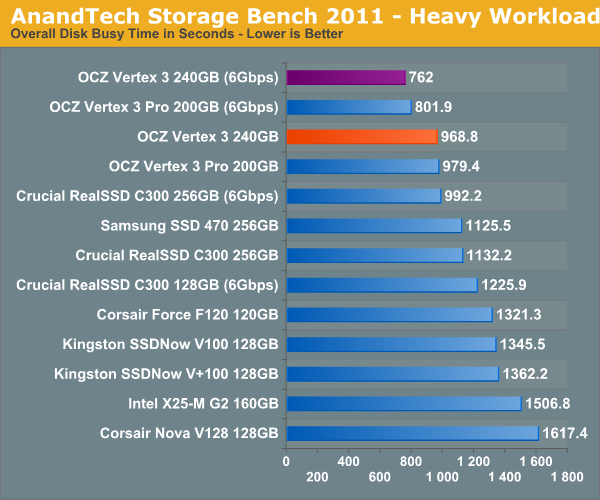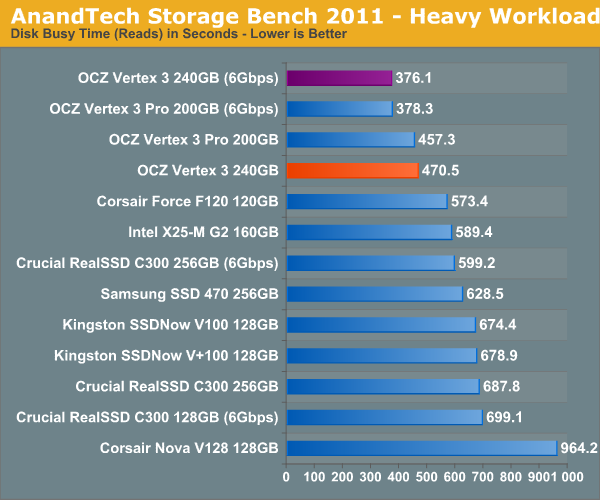OCZ Vertex 3 Preview: Faster and Cheaper than the Vertex 3 Pro
by Anand Lal Shimpi on February 24, 2011 9:02 AM ESTAnandTech Storage Bench 2011: Much Heavier
I didn't expect to have to debut this so soon, but I've been working on updated benchmarks for 2011. Last year we introduced our AnandTech Storage Bench, a suite of benchmarks that took traces of real OS/application usage and played them back in a repeatable manner. I assembled the traces myself out of frustration with the majority of what we have today in terms of SSD benchmarks.
Although the AnandTech Storage Bench tests did a good job of characterizing SSD performance, they weren't stressful enough. All of the tests performed less than 10GB of reads/writes and typically involved only 4GB of writes specifically. That's not even enough exceed the spare area on most SSDs. Most canned SSD benchmarks don't even come close to writing a single gigabyte of data, but that doesn't mean that simply writing 4GB is acceptable.
Originally I kept the benchmarks short enough that they wouldn't be a burden to run (~30 minutes) but long enough that they were representative of what a power user might do with their system.
Not too long ago I tweeted that I had created what I referred to as the Mother of All SSD Benchmarks (MOASB). Rather than only writing 4GB of data to the drive, this benchmark writes 106.32GB. It's the load you'd put on a drive after nearly two weeks of constant usage. And it takes a *long* time to run.
I'll be sharing the full details of the benchmark in some upcoming SSD articles (again, I wasn't expecting to have to introduce this today so I'm a bit ill prepared) but here are some details:
1) The MOASB, officially called AnandTech Storage Bench 2011 - Heavy Workload, mainly focuses on the times when your I/O activity is the highest. There is a lot of downloading and application installing that happens during the course of this test. My thinking was that it's during application installs, file copies, downloading and multitasking with all of this that you can really notice performance differences between drives.
2) I tried to cover as many bases as possible with the software I incorporated into this test. There's a lot of photo editing in Photoshop, HTML editing in Dreamweaver, web browsing, game playing/level loading (Starcraft II & WoW are both a part of the test) as well as general use stuff (application installing, virus scanning). I included a large amount of email downloading, document creation and editing as well. To top it all off I even use Visual Studio 2008 to build Chromium during the test.
Many of you have asked for a better way to really characterize performance. Simply looking at IOPS doesn't really say much. As a result I'm going to be presenting Storage Bench 2011 data in a slightly different way. We'll have performance represented as Average MB/s, with higher numbers being better. At the same time I'll be reporting how long the SSD was busy while running this test. These disk busy graphs will show you exactly how much time was shaved off by using a faster drive vs. a slower one during the course of this test. Finally, I will also break out performance into reads, writes and combined. The reason I do this is to help balance out the fact that this test is unusually write intensive, which can often hide the benefits of a drive with good read performance.
There's also a new light workload for 2011. This is a far more reasonable, typical every day use case benchmark. Lots of web browsing, photo editing (but with a greater focus on photo consumption), video playback as well as some application installs and gaming. This test isn't nearly as write intensive as the MOASB but it's still multiple times more write intensive than what we were running last year.
As always I don't believe that these two benchmarks alone are enough to characterize the performance of a drive, but hopefully along with the rest of our tests they will help provide a better idea.
The testbed for Storage Bench 2011 has changed as well. We're now using a Sandy Bridge platform with full 6Gbps support for these tests. All of the older tests are still run on our X58 platform.
AnandTech Storage Bench 2011 - Heavy Workload
We'll start out by looking at average data rate throughout our new heavy workload test:

If we break out our performance results into average read and write speed we get a better idea for the Vertex 3's strengths:


The next three charts just represent the same data, but in a different manner. Instead of looking at average data rate, we're looking at how long the disk was busy for during this entire test. Note that disk busy time excludes any and all idles, this is just how long the SSD was busy doing something:













85 Comments
View All Comments
Figaro56 - Tuesday, March 1, 2011 - link
Excuse me, but I'm confused. Why would a person rather get a refurb? For the warranty?What do you think a refurb part is any way? It's someone's used part that is not only used, but it also had a mfg defect. Are you kidding me?!
Figaro56 - Tuesday, March 1, 2011 - link
If you think a refurb in some way has more value go for it. I have never had a problem buying used from someone, just stay away from bad used parts venues like Ebay or Craigslist.Figaro56 - Tuesday, March 1, 2011 - link
I got my C300 256GB as an early adopter when they finally fixed their infamous firmware issue. That's cost you pay for being an "early adopter enthusiast."zebrax2 - Thursday, February 24, 2011 - link
Games i believe are sequential in naturesticks435 - Thursday, February 24, 2011 - link
This is correct. They are sequential reads. I really wish they Anand would have shown the PC Vantage gaming scores. Hopefully the full review will them them, along with the test bench 2010 on the Sandy bridge platform, since the new bench is only 2 workloads and gaming is a very specific type of workload.B3an - Friday, February 25, 2011 - link
I'd also like to see more real world and basic tests. Normal everyday things. As mentioned, Win7 start times, Photoshop tests, game loading times and so on...Figaro56 - Friday, February 25, 2011 - link
I own a Crucial RealSSD C300 256GB myself. After reading this review I have come to the same conclusion. Yes there is a margin of performance improvement with the Vertex 3, but not so great as to make you crazy enough to sell your C300 for $100 and jump on the OCZ Vertex 3 test group. I would wait awhile to see how this Vertex 3 with it's questionable new 25nm NAND holds up in the real world. I was never a fan of their new idea of data compression from the get go either. I still view this as a grand experiment at our expense. It's smart to stick with what works even if next month it will be come 2nd best.Figaro56 - Friday, February 25, 2011 - link
See my post below dated Friday, February 25, 2011, it was intended as a reply to your post. I don't know why it didn't stack in here as a reply.Figaro56 - Friday, February 25, 2011 - link
RE: What about load times? by Figaro56 on Friday, February 25, 2011I own a Crucial RealSSD C300 256GB myself. After reading this review I have come to the same conclusion. Yes there is a margin of performance improvement with the Vertex 3, but not so great as to make you crazy enough to sell your C300 for $100 and jump on the OCZ Vertex 3 test group. I would wait awhile to see how this Vertex 3 with it's questionable new 25nm NAND holds up in the real world. I was never a fan of their new idea of data compression from the get go either. I still view this as a grand experiment at our expense. It's smart to stick with what works even if next month it will be come 2nd best.
jimhsu - Friday, February 25, 2011 - link
Actually with the whole OCZ mess, questionable firmware policies, and completely unknown lifespan or reliability, I'm not sure I even want to buy the Vertex 3 at half its current price, despite the performance figures here. In this case I think the C300 is actually worth more -- at least the drive has been mostly debugged and the firmware vetted, unlike this.